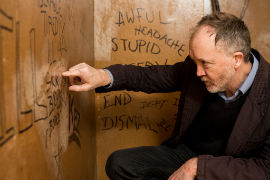I woke up to act just during the last few weeks of the touring exhibition of the replicas of the grave goods of the tomb of Tutankhamun, named Tutankhamun – Graven och skatterna (tomb and treasures). First I had considered not going due to the high cost of tickets and the fact that the artefacts there are not real, but replicas. But then in the end the curiosity was too much after I got quite good feedback from my colleagues.
The price was high – and higher on Sundays. You can guess which weekday I was visiting the exhibition. The location was unusual. The exhibition had moved to the Magasin 9 in the Frihamn area. I had to consult my map and Google Maps before going. Luckily, nowadays it is easy to check which buses go where online or on a mobile phone app. The SL provided the potential routes to the place.
The exhibition itself is a commercial venture, I believe, even if the Egyptian archaeological authorities are involved somehow and the former chief inspector and minister Zahi Hawass visited Stockholm during the exhibition. A similar exhibition is currently advertised for Dorchester, Dorset, on the Internet, but according to Wikipedia this exhibition is permanent. The web page was almost identical, so the organization behind it is the same. According Wikipedia, the touring exhibition has been in Zürich, Brno, Munich, and Barcelona among other places.
The entrance to the exhibition was slightly chaotic with the obligatory information panels of the Egyptian chronology, the station to deliver the audioguides and the area to queue to the film and through it to the main exhibits occupying more or less the same space. The whole exhibition is based on audioguides and I must say that the texts were at the same time thorough and targeted to the general audience. The number of stops had also been carefully considered and the exhibition lasted about two hours when one listened all the 22 texts and saw the movie.
The exhibits in the area before the movie concentrated on the finding Tutankhamun, how archaeologists found about him and how long it took from Howard Carter to find the tomb. Many have not considered that he was on the trail of the boy pharaoh for about 15 years. Naturally, this section covered the death of Lord Carnarvon and the curse of the pharaoh. The film afterwards also concentrated on Howard Carter and the finding of the tomb. After the film we were presented with the tomb itself so everything proceeded in a chronological order.
The tomb section was a disappointment of the exhibition: one could not walk among the stacked items but only see reproductions at a distance. The spaces presented also omitted the Annex, so not all rooms were reproduced. However, for a non-egyptologist what followed was engaging and spectacular. I am usually a purist and frown somewhat the exhibitions where there are few or no original objects, but here my childhood love of all things Tut won, and I enjoyed the exhibition fully.
I did not find the mask of the Tutankhamun very exciting but I thought the displays got better towards the end where the chariot and the famous throne were presented. These are fantastic objects and the copies will do when presented in a professional matter. I also learned new or forgotten things. I found the fact that an aborted fetus and a stillborn baby had been buried with the boy king very touching and it was revealing to see the copies of the actual small sarcophagi that were very small in comparison with the huge copies of the real Tut things.
Inadvertedly, the exhibits showed how the selection of objects only gives us a glimpse what the real treasures of the pharaohs were. The throne may have been Ekhnaten’s, the baby’s mask was too big and could not be fitted on the little mummy to make it fit the sarcophagus, and there were also other recycled items. This tomb had also been robbed soon after the funeral and all objects in precious metals that were not inside the sarcophagi had vanished. The wooden items covered in leaf gold were left to reflect the splendours of the past.
Was the exhibition value for money (195 Swedish krona)? Well, it was until I check the price of the adult tickets in the Dorchester exhibition. It is £8.99 that would be a price one would have a casual walk through the galleries. With the Swedish price one does spend more time and effort in marveling the exhibits.






